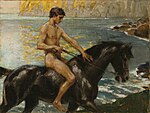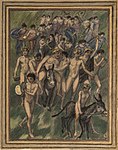Ludwig von Hofmann
Ludwig von Hofmann (born August 17, 1861 in Darmstadt , † August 23, 1945 in Pillnitz near Dresden ) was a German painter, graphic artist and designer. His works, created over a period of more than 60 years, combine elements of Symbolism with Art Nouveau , but are also influenced by other artistic movements of his time, from Historicism to the New Objectivity . He was a pioneer of the New Weimar movement .
life and work
Hofmann was a son of the Prussian statesman Karl Hofmann , who was Prime Minister of the Grand Duchy of Hesse from 1872 to 1876 and was raised to hereditary nobility as Minister of Commerce in the Bismarck cabinet in 1882. His uncles were the painters Rudolf and Heinrich Ferdinand Hofmann .
Ludwig Hofmann studied at the Academy of Fine Arts in Dresden from 1883 and later switched to Ferdinand Keller at the Karlsruhe Art Academy . In 1889 he studied at the Académie Julian in Paris and was under the influence of French artists such as Pierre Puvis de Chavannes and Paul-Albert Besnard .
From 1890 Hofmann worked as a freelance artist in Berlin. There he belonged to the " group of eleven " (with Max Klinger , Max Liebermann and others). In the period from 1894 to 1900 Hofmann traveled a lot and spent most of his time in Rome and in his villa near Fiesole . Throughout his life, the reception of antiquity and his idea of an Arcadia were to have a decisive influence on his work. From 1895 Hofmann contributed numerous illustrations to the most influential German Art Nouveau magazine " Pan ". At the international art exhibition in Berlin in 1896 he received a small gold medal. From 1898 he was a member of the " Berlin Secession ". In 1899 he married Eleonore Kekulé von Stradonitz.

In 1903 he was appointed professor at the Grand Ducal Art School in Weimar , where he associated with many representatives of the artistic and literary avant-garde in the circle of Harry Graf Kessler and Henry van de Velde and became a pioneer of Kessler's " New Weimar " movement . Hans Arp and Ivo Hauptmann were among his students in Weimar . He became friends with his father, the Nobel Prize for Literature, Gerhart Hauptmann , which was reflected in extensive correspondence and a joint trip to Greece in 1907. Hofmann worked with van de Velde on several construction projects.
During the war in 1916, Hofmann moved to the Art Academy in Dresden , where he succeeded Hermann Prell as a professor for monumental painting until 1931. It was during this time that the reading room of the German Library in Leipzig was designed (1919). With Marcus Behmer he created illustrations for important works of poetry, for example for Leopold Ziegler's Odyssey translation or Gerhart Hauptmann's shepherd's song .
In the 1920s and 1930s things got quieter around Hofmann. In 1937, some works in Erfurt were ostracized as " degenerate art ", but others continued to be exhibited in Germany. In 1945 Hofmann died in Pillnitz. His grave is in the Maria am Wasser churchyard in Dresden-Hosterwitz.
Ludwig von Hofmann was a member of the German Association of Artists .
reception
Hofmann's admirers and collectors of his works included the Austro-Hungarian Empress Elisabeth , the banker and important patron August Freiherr von der Heydt , the publisher Rudolf Mosse and the art historians Heinrich Wölfflin and Wilhelm von Bode . In 1898, Rainer Maria Rilke dedicated the cycle of poems “Die Bilder Along” (see also publications) to Hofmann (inspired by Hofmann's drawings); Hofmann had already provided Rilke's cycle of poems "Songs of the Girls" with illustrations. Even Thomas Mann admired Hofmann and processed impressions of Hofmann's work in his novel " The Magic Mountain ". The picture, The Source, bought in 1914, hung in his study until his death . Hugo von Hofmannsthal wrote a foreword to Hofmann's graphic portfolio "Tänze" in 1905.
In art criticism as early as the 1920s and 1930s - and especially in the post-war period from 1945 - Hofmann, like many Art Nouveau artists, was barely noticed, and his work was increasingly forgotten. Since the 1990s there has been an increased engagement with his work through art historical science and through exhibitions. The highlight of this renaissance so far is the large Hofmann exhibition “Arcadian Utopias in Modernism” in his native Darmstadt in 2005, the extensive catalog of which highlights various aspects of Hofmann's work in numerous articles.
At the time, he was one of the preferred selection of contemporary artists that the “Committee for the Procurement and Evaluation of Stollwerck Pictures” suggested to the Cologne chocolate producer Ludwig Stollwerck to commission them with drafts.
Collections
Hofmann's artistic estate was saved from confiscation by the Russian occupation forces by his widow in 1945 and passed on to her great-nephew, Dr. Arnulf Carrière, whom she named in her will as the sole heir, bequeathed him. A small part of the estate came into the custody of the State Art Collections Weimar. Ludwig von Hofmann's estate is now in Potsdam (Brandenburg), where the Ludwig von Hofmann Society is also based. Numerous acquisitions made the Zurich Ludwig Hofmann archive owned by the Swiss Peter Hüssy an important private Hofmann collection. A transfer of Hüssy's collection to Weimar was planned, but failed due to a lack of funds from the Weimar Classic Foundation. With the death of Peter Hüssy, all of the aforementioned efforts came to a standstill. The collection is gradually being dissolved. There was a legal dispute over several years over the estate, in which the ownership structure of the estate had to be clarified. A 2005 ruling by the Dresden Regional Court determined that the Weimar Classic and Art Collections Foundation was not entitled to any copyrights or rights of use to the works of the “artistic estate of Ludwig von Hofmann” [AZ. 5 O 5238/04].
Publications (selection)
- Dances. Insel, Leipzig 1905.
- Edwin Redslob (ed.): Hand drawings. Kiepenheuer, Weimar 1918.
- Ephraim Rosenstein (Ed.): Along the pictures, Ludwig von Hofmann and Rainer Maria Rilke. Berlin 1998.
literature
- Hofmann, Ludwig von . In: Hans Vollmer (Hrsg.): General lexicon of fine artists from antiquity to the present . Founded by Ulrich Thieme and Felix Becker . tape 17 : Heubel – Hubard . EA Seemann, Leipzig 1924, p. 272 .
- Ludwig von Hofmann . In: General Artist Lexicon . The visual artists of all times and peoples (AKL). Volume 74, de Gruyter, Berlin 2012, ISBN 978-3-11-023179-3 , pp. 144ff ..
- Oskar Fischel : Ludwig von Hofmann (= artist monographs. Volume 63). Velhagen & Klasing, Bielefeld and Leipzig 1903.
- Ludwig von Hofmann. First overview of the artist's work from 1891–1916. Directory of the exhibition at Galerie Ernst Arnold, January 10 to mid-February 1917. Galerie Ernst Arnold, Dresden 1917.
- Gertraude Lippold: Hofmann, Ludwig von. In: New German Biography (NDB). Volume 9, Duncker & Humblot, Berlin 1972, ISBN 3-428-00190-7 , pp. 458 f. ( Digitized version ).
- Herta Hesse-Frielinghaus (ed.): Gerhart Hauptmann - Ludwig von Hofmann. Correspondence 1894–1944. Bouvier, Bonn 1983, ISBN 3-416-01714-5 .
- Verena Senti-Schmidlin: The dance as a picture motif. Ludwig von Hofmann 1861–1945. Lang, Bern et al. 1999, ISBN 3-906761-86-X .
- Contessa Roberts: In search of “the land of the Greeks that floated away”. The painter and graphic artist Ludwig von Hofmann (1861–1945). An overview of his oeuvre with a special focus on drawings and prints. Dissertation, University of Freiburg 2001 ( full text ).
- Verena Senti-Schmidlin: Rhythm and dance in painting. On the aesthetics of movement in the work of Ferdinand Hodler and Ludwig von Hofmann (= studies on art history. Volume 170). Olms, Hildesheim 2007, ISBN 978-3-487-13405-5 (plus dissertation, University of Friborg 2006).
- Annette Wagner, Klaus Wolbert (ed.): Ludwig von Hofmann (1861–1945). Arcadian utopias in modern times. City of Darmstadt, Darmstadt 2005, ISBN 3-935062-05-2 .
- Rolf Günther: The symbolism in Saxony 1870-1920. Sandstein Verlag, Dresden 2005, ISBN 3-937602-36-4 .
- Claus Bernet : Ludwig von Hofmann's "Dreaming". A Berlin picture story. Kadmos, Berlin 2011, ISBN 3-86599-142-4 .
- City collections Freital , Burgk Castle (ed.): Ludwig von Hofmann: Longing for paradise. Sandstein Verlag, Dresden 2011, ISBN 978-3-942422-54-3 .
Web links
- Literature by and about Ludwig von Hofmann in the catalog of the German National Library
- Ludwig von Hofmann Society V., Potsdam (only contact address, as of January 2019)
- Saxonia Gallery: Ludwig von Hofmann
- Ludwig von Hofmann Archive
Individual evidence
- ↑ kuenstlerbund.de: Full members of the German Association of Artists since it was founded in 1903 / Hofmann, Ludwig von ( Memento from March 4, 2016 in the Internet Archive ) (accessed on August 30, 2015).
- ↑ Detlef Lorenz: Advertising art around 1900. Artist lexicon for collecting pictures. Reimer-Verlag, Berlin 2000.
| personal data | |
|---|---|
| SURNAME | Hofmann, Ludwig von |
| BRIEF DESCRIPTION | German painter, graphic artist and designer |
| DATE OF BIRTH | 17th August 1861 |
| PLACE OF BIRTH | Darmstadt |
| DATE OF DEATH | August 23, 1945 |
| Place of death | Pillnitz near Dresden |






